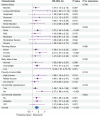Association between hysterectomy status and stroke risk and cause-specific and all-cause mortality: evidence from the 2005-2018 National Health and Nutrition Examination Survey
- PMID: 37273708
- PMCID: PMC10233142
- DOI: 10.3389/fneur.2023.1168832
Association between hysterectomy status and stroke risk and cause-specific and all-cause mortality: evidence from the 2005-2018 National Health and Nutrition Examination Survey
Abstract
Background: Prior research on women who had hysterectomies has shown mixed results on whether or not hysterectomies increased the incidence of stroke and cause-specific or all-cause mortality.
Methods: Using information from the Continuous National Health and Nutrition Examination Survey (NHANES) in the United States, including linked mortality follow-up files available for public access, a multicycle cross-sectional design mortality linkage study was performed.
Results: Conducted during the years 2005-2018, the study sample included 14,214 female participants ranging in age from 20 to 85 years. The relationship between the hysterectomy status and the risk of stroke and cause-specific and all-cause mortality was examined using a series of weighted logistic regressions and Cox proportional hazards regressions, respectively. The presence of a hysterectomy was consistently linked to an elevated risk of stroke using weighted logistic regression models. The hysterectomy status, however, consistently showed no effect on survival by adjusted weighted Cox regression analysis.
Conclusion: Our study found a significant association between hysterectomy and stroke, even after adjusting for other factors that could impact risk, such as the American Heart Association (AHA)'s Life's Simple 7 cardiovascular health score and variables of age, ethnicity, marital status, income, education, and depression severity.
Keywords: NHANES; hysterectomy; mortality; stroke; women's health issues.
Copyright © 2023 Shen, Wang, Tian, Wang, Guo, Shen, Liu and Zou.
Conflict of interest statement
The authors declare that the research was conducted in the absence of any commercial or financial relationships that could be construed as a potential conflict of interest.
Figures



Similar articles
-
Association between socioeconomic status and arteriosclerotic cardiovascular disease risk and cause-specific and all-cause mortality: Data from the 2005-2018 National Health and Nutrition Examination Survey.Front Public Health. 2022 Nov 22;10:1017271. doi: 10.3389/fpubh.2022.1017271. eCollection 2022. Front Public Health. 2022. PMID: 36483261 Free PMC article.
-
Association between level of depression and coronary heart disease, stroke risk and all-cause and cardiovascular mortality: Data from the 2005-2018 National Health and Nutrition Examination Survey.Front Cardiovasc Med. 2022 Oct 26;9:954563. doi: 10.3389/fcvm.2022.954563. eCollection 2022. Front Cardiovasc Med. 2022. PMID: 36386369 Free PMC article.
-
The Role of Cancer in the Risk of Cardiovascular and All-Cause Mortality: A Nationwide Prospective Cohort Study.Int J Public Health. 2023 Oct 19;68:1606088. doi: 10.3389/ijph.2023.1606088. eCollection 2023. Int J Public Health. 2023. PMID: 37927387 Free PMC article.
-
Egg Consumption and Risk of Total and Cause-Specific Mortality: An Individual-Based Cohort Study and Pooling Prospective Studies on Behalf of the Lipid and Blood Pressure Meta-analysis Collaboration (LBPMC) Group.J Am Coll Nutr. 2019 Aug;38(6):552-563. doi: 10.1080/07315724.2018.1534620. Epub 2019 Jun 7. J Am Coll Nutr. 2019. PMID: 31173548
-
Non-Alcoholic Fatty Liver Disease, Heart Failure, and Long-Term Mortality: Insights From the National Health and Nutrition Examination Survey.Curr Probl Cardiol. 2022 Dec;47(12):101333. doi: 10.1016/j.cpcardiol.2022.101333. Epub 2022 Jul 25. Curr Probl Cardiol. 2022. PMID: 35901855 Review.
Cited by
-
Prevalence of cardiometabolic outcomes in women who underwent salpingo-oophorectomy to prevent hereditary breast and ovarian cancer: a meta-analysis.Fam Cancer. 2024 Nov 15;24(1):5. doi: 10.1007/s10689-024-00431-x. Fam Cancer. 2024. PMID: 39546060
-
The Carolina hysterectomy cohort (CHC): a novel case series of reproductive-aged hysterectomy patients across 10 hospitals in the US south.BMC Womens Health. 2023 Dec 19;23(1):674. doi: 10.1186/s12905-023-02837-8. BMC Womens Health. 2023. PMID: 38114962 Free PMC article.
References
-
- Centers for Disease Control Prevention . Women's Reproductive Health: Hysterectomy. Available online at: https://www.cdc.gov/reproductivehealth/womensrh/#hysterectomy (accessed November 12, 2020).
LinkOut - more resources
Full Text Sources

